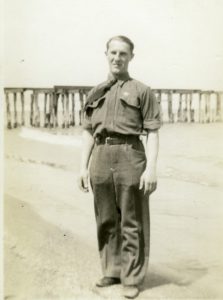Much like Ed Drab, most of the young men working for the Civilian Conservation Corps came from rural backgrounds. Only thirteen percent had completed high school, and some were functionally illiterate. Recruits like Ed were paid $30 per month, $25 of which he sent home to his sister Rose Mary and the rest of his family.
Some members advanced to leadership positions at a higher salary. Enrollees were issued surplus World War I uniforms for clothing and were inducted for a six-month term, which could be extended for up to two years.
Ed recalled with humor his first day in camp when he was ordered to climb a forest fire watchtower. He confidently scurried up the tower but then froze in fear. A camp officer had to climb up, take him by the hand, and lead him down. In spite of this embarrassment, Ed recalled in his late 90s that the camaraderie of his fellow recruits, and the guidance of his commanding officers made serving in the CCC one of the most rewarding experiences of his life.
A Typical Day for a Camp 657 Enrollee
Camp 657 in Elcho was typical of CCC camps across the country in that it contained five barracks housing about 40 enrollees each. Camps also included a mess hall, canteen, educational building with a library, shops, hospital, headquarters, and supply buildings.

A typical day began with reveille and flag-raising at 6:00am. After a round of calisthenics, a hearty breakfast, and barracks and grounds cleanup, enrollees left for their work assignments at 7:45. Lunch was often served in the field and the men were back in camp by 4:00pm. After cleaning up and lowering the flag at 5:00pm, enrollees would assemble for their evening meal. From the end of supper until the call for ‘lights out’ at 10:00pm, enrollees were free to attend classes, read, or play games or sports in the recreation hall.
Camp 657 enrollees had a number of obligations outside of their work duties, including weekly lectures on personal hygiene, safety, and etiquette. Saturday mornings were often spent on camp maintenance, while afternoons and evenings brought a number of recreational activities that included occasional dances held in the camp. On special nights, a camp truck might also take the men to town for an evening out.

The young men of Camp 657 had several recreational options. The more musically inclined formed a band that would send off departing or greet arriving enrollees at the Elcho train depot. Boxing was a popular activity, as it required minimal space and equipment. Enrollees also formed basketball, baseball, and football teams that competed against other camps and high school teams. Camp 657 requested and received discarded uniforms used by the Green Bay Packers for their football team. Enrollees would also ice skate and socialize with young men and women from Elcho and would attend events such as dances in town. On their expeditions into town, enrollees congregated at the High Point Bar in Summit Lake, a favorite spot that served as the site for reunions for enrollees well into the 1980s.

Like over 3,000 CCC camps across the United States, enrollees at Camp 657 published a camp newspaper. The camp’s first periodical, entitled the Woodchopper, was a mimeographed publication, meaning copies were produced using a stencil, that usually contained four to six pages. The burgeoning journalists later expanded their writing to the Elcho Eagle, a newsprint edition that sometimes ran up to eight pages. The paper mostly contained camp news and humor of local interest with an occasional story taken from the nation-wide CCC weekly, Happy Times, printed in Washington D.C.

Although Ed’s time at Camp 657 was filled with activity and camaraderie, daily life in the CCC remained a very regimented and Spartan-like experience in a male-dominated environment. The commemorative pillow sham and sweater that his sister Rose Mary had made for him no doubt provided a comforting reminder of home and family life.
Interestingly, many CCC recruits from all over the country also sent commemorative pillow shams from camp to home as both souvenirs of their service and expressions of homesickness for both mothers and sweethearts alike.
Written by Joe Hermolin, February 2016.
SOURCES
Interview with Edward Drab, 2007, Langlade County Historical Society archives.
Perry H. Merril, Roosevelt’s Forest Army: A History of the Civilian Conservation Corps, 1933-1942(Montpelier, VT: P.H. Merrill, 1981).
Alfred E. Cornebise, The CCC Chronicles: Camp Newspapers of the Civilian Conservation Corps 1933-1942 (Jefferson, NC: McFarland & Co., Inc., 2004)
Interview with Edward Drab, 2007, Langlade County Historical Society archives.
Alfred E. Cornebise, The CCC Chronicles: Camp Newspapers of the Civilian Conservation Corps 1933-1942 (Jefferson, NC: McFarland & Co., Inc., 2004). For more information on CCC Camp 657 Elcho, explore Langlade County Historical Society’s digital collection for the camp
Alfred E. Cornebise, The CCC Chronicles: Camp Newspapers of the Civilian Conservation Corps 1933-1942 (Jefferson, NC: McFarland & Co., Inc., 2004).
Alfred E. Cornebise, The CCC Chronicles: Camp Newspapers of the Civilian Conservation Corps 1933-1942 (Jefferson, NC: McFarland & Co., Inc., 2004).
See: Langlade County Historical Society’s digital collection for the camp.
Featured image: Civilian Conservation Corps Camp 657 temporary barracks at Summit Lake, WI, c. 1933. Photograph courtesy of the Langlade County Historical Society.
RELATED STORIES

The Great Depression in Langlade County

An Immigrant Family in Rural Wisconsin

The Civilian Conservation Corps



